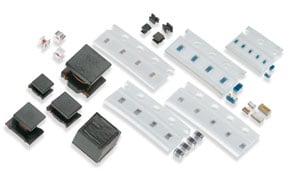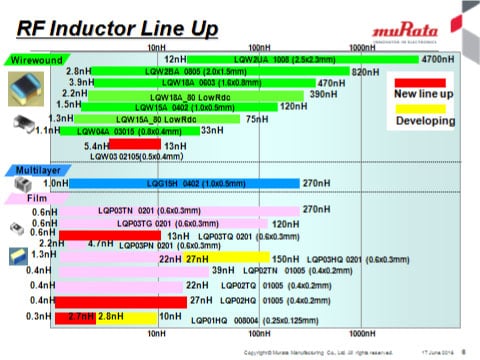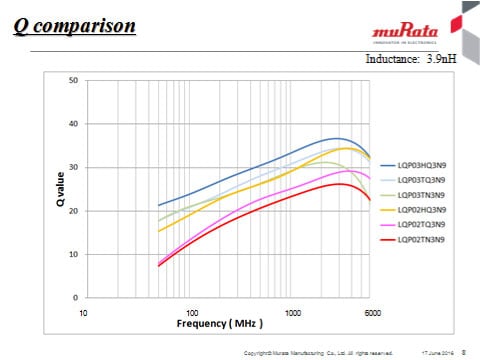Inductors

Inductor Guide
Small RF inductors, which are used in the RF circuits of mobile phones and other communications equipment, can be categorized into three types depending on how they are constructed.
Since each inductor has its own characteristics, this article presents the characteristics of each inductor and the points to keep in mind when selecting an inductor.
You can search RF inductor lineup here
RF inductors can be categorized into three types: wire wound, multilayer, and film.
Figure 1 shows what each type looks like.

In a wire wound inductor, a coil is formed by winding wire around a non-magnetic core.
The wire wound type is characterized by a high Q (Quality factor) value, low DC resistance, support for large currents, and high inductance.
Because of its high Q value (a value indicating the quality of the coil), the wire wound type is particularly popular for use in peripheral antenna circuits.
In the case of multilayer inductors, coils are formed by printing coil patterns on non-magnetic sheets and stacking them. Multilayer inductors are characterized by compact high performance and high reliability and are used in general RF circuits.
In the film type inductor, a coil is formed in the same method as the semiconductors in an integrated circuit (that is, by exposing a photosensitive film to light).
In addition to its compact size and high performance, the film inductor is characterized by its low profile, tight tolerances for inductance, and small inductance value steps.
It is widely used in impedance matching circuitry in high frequency circuits that require stable induction and small inductance value steps. However, in recent years there have been efforts to develop High Q film inductors, and they are increasingly used in peripheral antenna circuits, which require High Q components.
In some cases, the film type is placed in the same category as the multilayer type.
Table 1 organizes the RF inductors by their type of construction, their characteristics, and the circuits they are used in.
Table 1. Types of RF inductors, their characteristics, and the circuits they are used in
| Type | Characteristics | Circuits used in |
|---|---|---|
| Wire wound | High Q Low DC resistance Large current High inductance |
Peripheral antenna circuits |
| Multilayer | Compact and high performance High reliability |
General RF circuits |
| Film | Compact and high performance Low profile Tight tolerances for inductance Small inductance value steps High Q |
RF impedance matching circuits Peripheral antenna circuits |
Murata's product lineup of RF inductors is shown in Figure 2.

In the case of the wire wound type, Murata was able to achieve a compact size wire wound inductor with a minimum size of 0.5mm x 0.4mm.
For film type inductors, Murata has released the LQP01HQ series, which is the world's smallest at 0.25mm x 0.125mm, and is also pursuing product development in a wide variety of other sizes, inductance values, and series.
We have prepared a wide variation of Q values by size and series in order to enable customers to select the optimum series according to the required Q characteristics.
Figure 3 shows Q value comparison data for the LQP series.

Small RF inductors are used in the RF circuits of mobile phones and other communications equipment. It is important to select the optimum inductor component based on the required circuit and Q value characteristics.
By offering RF inductors of three different construction types (wire wound, multilayer, and film), Murata is able to support a wide range of RF circuits.
Yoshihiro Kurokawa
Product Engineering Section 1
Product Engineering Department
EMI Filter Division
Murata Manufacturing Co., Ltd.
The information presented in this article was current as of the date of publication. Please note that it may differ from the latest information.